JS ++ | Петли
В компьютерном программировании часто бывает, что вы хотите, чтобы фрагмент кода выполнялся более одного раза. Циклы - это программные операторы, которые позволяют обрабатывать такие случаи. JS ++ содержит циклы различных типов, и в этом руководстве мы рассмотрим некоторые из них. Однако мы начнем с изучения двух выражений, которые очень часто используются для облегчения использования циклов: оператора инкремента «++» и оператора декремента «-».
Примечание. Операторы увеличения и уменьшения, а также операторы цикла, которые мы рассмотрим в этом руководстве, работают аналогично их аналогам в таких языках, как JavaScript, Java, C ++ и C #.
«++» и «-»
Чтобы показать эти операторы в действии, давайте рассмотрим пример. Создайте новую папку и назовите ее «Петли». Затем создайте новый файл и назовите его «Loops.jspp». Напишите следующий код:
внешний $;
int я = 0;
$ ("# content"). append ("я сейчас", я, ";");
++ i;
$ ("# content"). append ("я сейчас", я, ";");
--я;
$ ("# content"). append ("я сейчас", я, ";");Сохраните Loops.jspp в папку Loops. Затем создайте второй файл с именем «Loops.html» и напишите следующее:
<!DOCTYPE html> <title>Loops program</title> <body> <p id="content"></p> <script src="http://code.jquery.com/jquery-1.12.4.min.js"></script> <script src="Loops.jspp.js"></script> </body> </html>
Save Loops.html to your Loops folder. Compile Loops.jspp and then open Loops.html in a browser. Your document should show that “++” increases the value of i by 1, and “–” decreases i by 1.
Как и в других языках программирования, «++» и «-» могут использоваться до или после переменной. Чтобы проиллюстрировать разницу между использованием этих «префиксов» и «постфиксов», измените код в Loops.jspp на следующий:
внешний $;
int я = 0;
int j = 0;
j = ++ i;
$ ("# content"). append ("j is now", j, ", and i is now", i, ";");
j = i ++;
$ ("# content"). append ("j is now", j, ", and i is now", i, ";");The variable i is incremented for the first time through the use of the prefix increment operator. This means that i is incremented before its value is used in the statement, and the value of j is therefore set to 1. When i is incremented for the second time, by contrast, it is through the use of the postfix increment operator. This means that i is incremented after its value is used in the statement, and the value of j therefore remains 1. The prefix / postfix distinction applies in exactly the same way to the two versions of the decrement operator.
«Пока» и «делать… пока»
Now let’s examine how we can use the increment and decrement operators in loops. We will look at three types of loops in this tutorial: while loops, do... while loops, and for loops. We begin with while loops.
The purpose of a while loop is to make some code – the loop body – execute repeatedly for as long as a particular condition is true. When the condition is no longer true, the loop body ceases to execute.
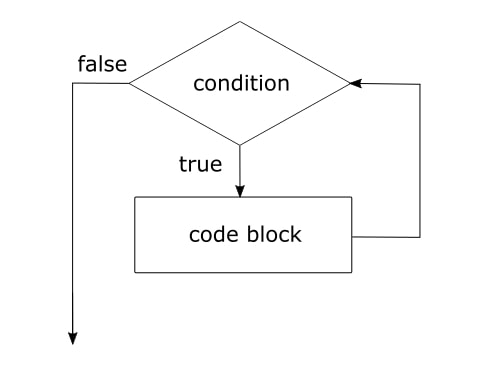
Возьмем пример. Измените код в Loops.jspp на следующий:
external $;
int i = 0;
while (i < 3){
$("#content").append("i is now ", i, "; ");
i++;
}Here we see the syntax of a while loop: the while keyword, followed by a pair of parentheses holding a condition to be checked, followed by a block of code in curly braces which will execute repeatedly for as long as the condition is true.
In this example, the loop executes three times: once when i is 0, a second time when i is 1, and a third time when i is 2. During the third execution i is incremented to 3; this means that when the condition (i < 3) is next checked, it is found to be false and the loop terminates.
What happens if the condition in a while loop is false from the outset? If so, the loop body will not execute. Your program’s execution simply continues to the first statement following the loop. That might be exactly the behaviour you want; in other cases it might not be. If instead you want your loop to execute at least once before checking whether a condition is true, there is a different kind of loop for that purpose: the do... while loop.
Измените код в Loops.jspp на следующий:
внешний $;
int я = 0;
делать {
$ ("# content"). append ("я сейчас", я, ";");
i ++;
}
в то время как (i> 10);In a do... while loop, the loop body is written after the do keyword, but before the condition to be checked. The loop executes at least once even if the condition is false on first time of checking, as it is in this example. When the condition is found to be false, the loop terminates.
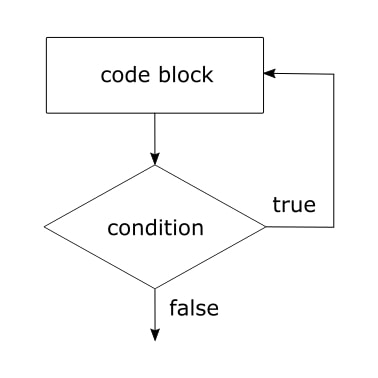
"для"
for loops differ from while and do... while loops in one important respect: the syntax of a for loop is specifically designed to facilitate the use of counter variables. Let’s take a look at an example:
external $;
for (int i = 0; i < 2; i++) {
$("#content").append("i is now ", i, "; ");
}The syntax of a for loop, as illustrated by this example, is somewhat more complex than that of a while or do... while loop so we will take a little more time to go over it. We can see that a for loop starts with the for keyword, which is then followed by some code in parentheses. The code in parentheses has three components, which are separated by semi-colons. The first part is the initialization component, where we declare our counter variable:
int i = 0;
Вторая часть - это компонент условия , который обеспечивает тест, чтобы определить, когда цикл должен завершиться:
я <3;
Третья часть - это компонент обновления , который обычно увеличивает или уменьшает значение счетчика:
я ++
Затем за кодом в круглых скобках следует тело цикла в фигурных скобках. Тело цикла состоит из выполняемых операторов.
A for loop proceeds as follows (see also the illustration below). First, the counter variable is initialized. Second, the condition is checked. If it is false then the loop terminates; if it is true then the loop continues to the next step. Third, the loop body executes. Fourth, the update component executes. Fifth, the loop returns to step two and repeats until the condition becomes false.
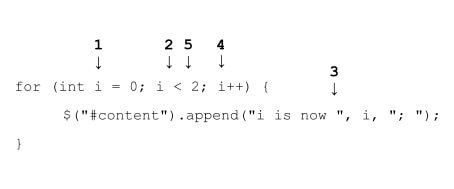
In our example, the loop body executes twice: once when the counter variable i is 0, and again when i is 1. After the second execution, the update component increments i to 2. This means that when the condition i < 2 is checked, it is found to be false and the loop terminates.
Note: The initialization, condition, and update components of a for
JS ++ для циклов
«Перерыв» и «продолжить»
The break and continue keywords give you extra flexibility in using loops, and both can be used in all the types of loops that we’ve examined. It is important to understand the difference between break and continue, however: break is used to terminate a loop immediately, whereas continue is used to skip to the next iteration.
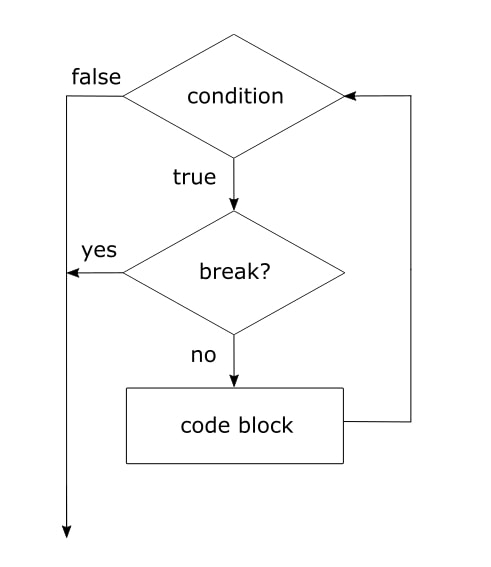
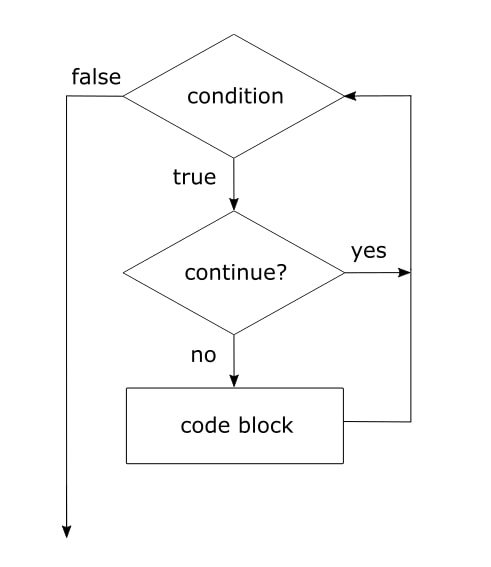
To illustrate the difference, let’s take an example involving a while loop:
external $;
int i = 0;
while (i < 3) {
i++;
if(i == 2) {
break;
}
$("#content").append("i is now ", i, "; ");
}If you write this code in to Loops.jspp, compile it, and then open Loops.html in a browser, it will display “i is now 1;”. It doesn’t display any more than that since the loop terminates midway through its second iteration, due to the use of break. If you remove break and replace it with continue, however, you will see a different result: Loops.html displays “i is now 1; i is now 3;”. This shows that continue doesn’t terminate the loop completely; it only terminates the current iteration, so that the loop skips ahead to the next iteration.
Nesting and labelled loops
Loops can be nested, which means putting one loop inside another. Here is an example of a nested for loop:
external $;
for (int i = 0; i < 2; i++) {
$("#content").append("i is now ", i, "; ");
for (int j = 0; j < 2; j++) {
$("#content").append("j is now ", j, "; ");
}
}В таких случаях, как этот, внутренний цикл проходит все свои итерации для каждой итерации внешнего цикла. В этом случае внешний цикл выполняется дважды, и для каждого из этих двух выполнений внутренний цикл выполняется дважды. Таким образом, внутренний цикл выполняется всего четыре раза.
If you want to use break or continue in nested loops, it can be useful to label your loops. For example, consider this use of break in a nested loop:
external $;
outer: for (int i = 0; i < 2; i++) {
$("#content").append("i is now ", i, "; ");
inner: for (int j = 0; j < 2; j++) {
if(j == 0) {
break outer;
}
$("#content").append("j is now ", j, "; ");
}
}By labelling the outer loop outer, we make it possible to refer to that loop when using the break statement inside the inner loop. This use of break therefore terminates the outer loop, not just the inner one. If we had not used labels, break would have referred to the inner loop since by default break refers to the innermost loop in which it occurs. Parallel remarks apply to continue: by default it refers to the innermost loop in which it occurs, but it can also refer explicitly to an outer loop via a label.